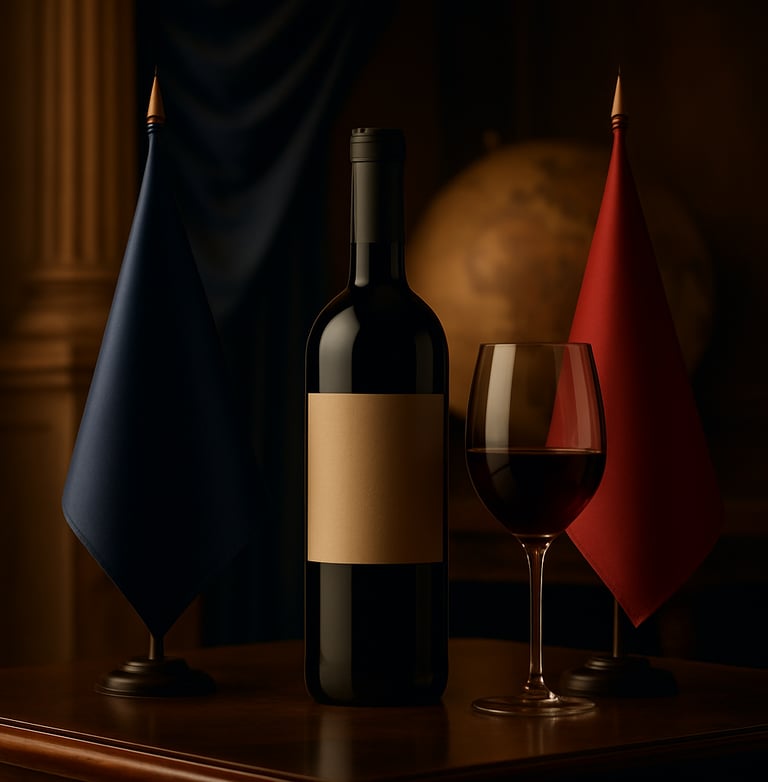
Liquid Diplomacy
Wine as a Tool of Cultural Power
11/13/2025


Introduction: The Wine That Travels Does Not Only Represent a Product — It Represents a Vision
In diplomatic halls, at State dinners, in multilateral meetings, in symbolic acts, wine appears. Not only as courtesy, but as a political gesture, an aesthetic declaration, and a resource of soft power. Modern diplomacy is no longer exercised only through speeches. It is also articulated through products that project identity, refinement, and territory. Fine wine, when managed with cultural intelligence, can become the most silent — and at the same time the most effective — tool of international positioning.
Wine as a Symbolic Ambassador
A well-chosen wine in an institutional context does not only please the palate: it conveys sophistication, belonging, territorial sensitivity, and history. And that symbolic capacity turns it into a resource of immense value for:
States
Regions
Regulatory councils
Cultural embassies
Nation brands with a vocation for prestige
Historical example: Tokaji was chosen by Louis XIV as “the wine of kings and the king of wines.” From that moment, Hungary built a cultural narrative around the prestige of the wine — one that endures to this day.
Cases of Regions and Brands That Have Exercised Liquid Diplomacy
✦ Champagne (France)
There is no global summit without a maison present. Not because it imposes itself commercially, but because it has become a universal code of celebration, civilisation, and refinement.
✦ Rioja (Spain)
Through cultural initiatives, ties with gastronomy, institutional presence, and long-term sensory storytelling, Rioja has consolidated itself as one of the most respected symbolic assets of Spain’s nation brand.
✦ Argentina and Malbec
The Argentine State has used Malbec at protocol events, fairs, and diplomatic tours as an emotional representation of modern national identity — especially when communicated alongside architecture, gastronomy, and contemporary art.
What Turns a Wine Into a Tool of Diplomacy
Not every bottle can operate as a cultural representation. To do so, it must meet strategic conditions:
Symbolic coherence between discourse, aesthetics, and origin.
Capacity to move without needing explanation.
Strategic selection of contexts: where that wine appears, with whom, and with what narrative.
Legitimacy: the product must be recognised as a bearer of authentic value, not mere marketing.
Recent example: Vin Santo served by Italy in religious and cultural ceremonies as an emblem of ancestral hospitality. The wine ceases to be a product and becomes a bridge between values, beliefs, and cultures.
What Wineries and Regions Can Do to Position Themselves Diplomatically
Define a narrative aligned with the universal values they wish to project: time, precision, beauty, sustainability, heritage, future.
Form alliances with local and international cultural actors: artists, designers, curators, institutions.
Be present in spaces that legitimise the narrative: cultural forums, curator-led dinners, strategic encounters.
Create tools that support the story: special editions, editorial content, hospitality experiences with diplomatic protocol.
Inspiring example: Penfolds Grange (Australia) appears at State dinners with cultural ambassadors. It does not impose itself as an icon of luxury: it is offered as an emblem of a sophisticated nation with a modern legacy.
Conclusion: Liquid diplomacy is not gifting wine — it is offering bottled culture
The well-chosen, well-narrated, and well-placed wine does not merely project a brand: it positions a way of understanding the world. 🍷 Because in a diplomatic toast, what is served is not just a glass. It is a story that represents who we are and what we want the world to remember about us.

